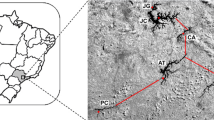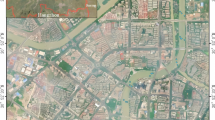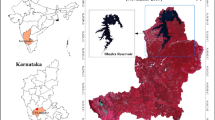Abstract
In recent years, Tri An, a drinking water reservoir for millions of people in southern Vietnam, has been affected by harmful cyanobacterial blooms (HCBs), raising concerns about public health. It is, therefore, crucial to gain insights into the outbreak mechanism of HCBs and understand the spatiotemporal variations of chlorophyll-a (Chl-a) in this highly turbid and productive water. This study aims to evaluate the predictable performance of both approaches using satellite band ratio and machine learning for Chl-a concentration retrieval—a proxy of HCBs. The monthly water quality samples collected from 2016 to 2018 and 23 cloud free Sentinel-2A/B scenes were used to develop Chl-a retrieval models. For the band ratio approach, a strong linear relationship with in situ Chl-a was found for two-band algorithm of Green-NIR. The band ratio-based model accounts for 72% of variation in Chl-a concentration from 2016 to 2018 datasets with an RMSE of 5.95 μg/L. For the machine learning approach, Gaussian process regression (GPR) yielded superior results for Chl-a prediction from water quality parameters with the values of 0.79 (R2) and 3.06 μg/L (RMSE). Among various climatic parameters, a high correlation (R2 = 0.54) between the monthly total precipitation and Chl-a concentration was found. Our analysis also found nitrogen-rich water and TSS in the rainy season as the driving factors of observed HCBs in the eutrophic Tri An Reservoir (TAR), which offer important solutions to the management of HCBs in the future.













Similar content being viewed by others
References
Adriana GC, Richard K (2017) Sentinel Data Access 2017 Annual Report vol 1. ESA
APHA (2005) Standard methods for the examination of water and wastewater, 21st edn. American Public Health Association/American Water Works Association/Water Environment Federation, Washington DC
Beaver JR, Tausz CE, Scotese KC, Pollard AI, Mitchell RM (2018) Environmental factors influencing the quantitative distribution of microcystin and common potentially toxigenic cyanobacteria in U.S. lakes and reservoirs. Harmful Algae 78:118–128. https://doi.org/10.1016/j.hal.2018.08.004
Blix K, Camps-Valls G, Jenssen R (2017) Gaussian process sensitivity analysis for oceanic chlorophyll estimation. IEEE J Sel Top Appl Earth Obs Remote Sens 10:1265–1277. https://doi.org/10.1109/JSTARS.2016.2641583
Blix K, Eltoft T (2018a) Evaluation of feature ranking and regression methods for oceanic chlorophyll-a estimation. IEEE J Sel Top Appl Earth Obs Remote Sens 11:1403–1418. https://doi.org/10.1109/JSTARS.2018.2810704
Blix K, Eltoft T (2018b) Machine learning automatic model selection algorithm for oceanic chlorophyll-a content retrieval. Remote Sens 10:775. https://doi.org/10.3390/rs10050775
Bresciani M, Cazzaniga I, Austoni M, Sforzi T, Buzzi F, Morabito G, Giardino C (2018) Mapping phytoplankton blooms in deep subalpine lakes from Sentinel-2A and Landsat-8. Hydrobiologia 824:197–214. https://doi.org/10.1007/s10750-017-3462-2
Bui M-H, Pham T-L, Dao T-S (2017) Prediction of cyanobacterial blooms in the Dau Tieng reservoir using an artificial neural network. Mar Freshw Res 68:2070. https://doi.org/10.1071/MF16327
Chen J, Zhu W, Tian YQ, Yu Q, Zheng Y, Huang L (2017) Remote estimation of colored dissolved organic matter and chlorophyll-a in Lake Huron using Sentinel-2 measurements. J Appl Remote Sens 11:1. https://doi.org/10.1117/1.JRS.11.036007
Chorus I, Bartram J (1999) Toxic cyanobacteria in water: a guide to their public health consequences, monitoring and management, published on behalf of WHO. Spon Press, London, 416 pp
Dao T-S, Nimptsch J, Wiegand C (2016) Dynamics of cyanobacteria and cyanobacterial toxins and their correlation with environmental parameters in Tri An Reservoir, Vietnam. J Water Health 14:669–712
Dippner JW, Nguyen-Ngoc L, Doan-Nhu H, Subramaniam A (2011) A model for the prediction of harmful algae blooms in the Vietnamese upwelling area. Harmful Algae 10:606–611. https://doi.org/10.1016/j.hal.2011.04.012
Gascon F, Bouzinac C, Thépaut O, Jung M, Francesconi B, Louis J, Lonjou V, Lafrance B, Massera S, Gaudel-Vacaresse A, Languille F, Alhammoud B, Viallefont F, Pflug B, Bieniarz J, Clerc S, Pessiot L, Trémas T, Cadau E, De Bonis R, Isola C, Martimort P, Fernandez V, Copernicus (2017) Sentinel-2A calibration and products validation status. Remote Sens 9:584. doi:https://doi.org/10.3390/rs9060584
Grendaitė D, Stonevičius E, Karosienė J, Savadova K, Kasperovičienė J (2018) Chlorophyll-a concentration retrieval in eutrophic lakes in Lithuania from Sentinel-2 data. Geologija Geografija 4:15–28. https://doi.org/10.6001/geol-geogr.v4i1.3720
Ha NTT, Koike K, Nhuan MT (2013) Improved accuracy of chlorophyll-a concentration estimates from MODIS imagery using a two-band ratio algorithm and geostatistics: as applied to the monitoring of eutrophication processes over Tien Yen Bay (Northern Vietnam). Remote Sens 6:421–442. https://doi.org/10.3390/rs6010421
Ha NTT, Koike K, Nhuan MT, Canh BD, Thao NTP, Parsons M (2017a) Landsat 8/OLI two bands ratio algorithm for chlorophyll-a concentration mapping in hypertrophic waters: An application to west lake in Hanoi (Vietnam). IEEE J Sel Top Appl Earth Obs Remote Sens 10:4919–4929. https://doi.org/10.1109/JSTARS.2017.2739184
Ha NTT, Thao NTP, Koike K, Nhuan MT (2017b) Selecting the best band ratio to estimate chlorophyll-a concentration in a tropical freshwater lake using sentinel 2A images from a case study of Lake Ba Be (northern Vietnam). ISPRS Int J Geo Inf 6:290. https://doi.org/10.3390/ijgi6090290
Imai H, Chang KH, Kusaba M, Si N (2008) Temperature-dependent dominance of Microcystis (Cyanophyceae) species: M. aeruginosa and M. wesenbergii. J Plankton Res 31:171–178. https://doi.org/10.1093/plankt/fbn110
Johnson R, Strutton PG, Wright SW, McMinn A, Meiners KM (2013) Three improved satellite chlorophyll algorithms for the Southern Ocean. J Geophys Res-Oceans 118(7):3694–3703. https://doi.org/10.1002/jgrc.20270
Karamizadeh S, Abdullah SM, Halimi M, Shayan J, Rajabi M (2014) Advantage and drawback of support vector machine functionality. In: 2014 international conference on computer, communications, and control technology (I4CT), 2014/09/2014. IEEE, Langkawi, Malaysia, pp 63–65. https://doi.org/10.1109/I4CT.2014.6914146
Keller S, Maier PM, Riese FM, Norra S, Holbach A, Börsig N, Wilhelms A, Moldaenke C, Zaake A, Hinz S (2018) Hyperspectral data and machine learning for estimating CDOM, chlorophyll a, diatoms, green algae and turbidity. Int J Environ Res Public Health 15:1881. https://doi.org/10.3390/ijerph15091881
Kosten S, Huszar VLM, Bécares E, Costa LS, van Donk E, Hansson L-A, Jeppesen E, Kruk C, Lacerot G, Mazzeo N, De Meester L, Moss B, Lürling M, Nõges T, Romo S, Scheffer M (2012) Warmer climates boost cyanobacterial dominance in shallow lakes. Glob Chang Biol 18(1):118–126. https://doi.org/10.1111/j.1365-2486.2011.02488.x
Kown Y, Baek S, Lim Y, Pyo J, Ligaray M, Park Y, Cho K (2018) Monitoring coastal chlorophyll-a concentrations in coastal areas using machine learning models. Water 10:1020. https://doi.org/10.3390/w10081020
Le C, Li Y, Zha Y, Sun D, Huang C, Lu H (2009) A four-band semi-analytical model for estimating chlorophyll a in highly turbid lakes: the case of Taihu Lake, China. Remote Sens Environ 113:1175–1182. https://doi.org/10.1016/j.rse.2009.02.005
Lee TA, Rollwagen-Bollens G, Bollens SM, Faber-Hammond JJ (2015) Environmental influence on cyanobacteria abundance and microcystin toxin production in a shallow temperate lake. Ecotox Environ Safe 114:318–325. https://doi.org/10.1016/j.ecoenv.2014.05.004
Li X, Sha J, Wang Z-L (2018) Application of feature selection and regression models for chlorophyll-a prediction in a shallow lake. Environ Sci Pollut R 25:19488–19498. https://doi.org/10.1007/s11356-018-2147-3
Lins R, Martinez J-M, Motta Marques D, Cirilo J, Fragoso C (2017) Assessment of chlorophyll-a remote sensing algorithms in a productive tropical estuarine-lagoon system. Remote Sens 9:516. https://doi.org/10.3390/rs9060516
Liu C, Tang D (2012) Spatial and temporal variations in algal blooms in the coastal waters of the western South China Sea. J Hydro-Environ Res 6:239–247. https://doi.org/10.1016/j.jher.2012.02.002
Lou I, Xie Z, Ung WK, Mok KM (2016) Freshwater algal bloom prediction by extreme learning machine in Macau storage. Neural Comput & Applic 27:19–26. https://doi.org/10.1007/s00521-013-1538-0
Maeda EE, Lisboa F, Kaikkonen L, Kallio K, Koponen S, Brotas V, Kuikka S (2019) Temporal patterns of phytoplankton phenology across high latitude lakes unveiled by long-term time series of satellite data. Remote Sens Environ 221:609–620. https://doi.org/10.1016/j.rse.2018.12.006
Martins V, Barbosa C, de Carvalho L, Jorge D, Lobo F, Novo E (2017) Assessment of atmospheric correction methods for sentinel-2 MSI images applied to Amazon floodplain lakes. Remote Sens 9:322. https://doi.org/10.3390/rs9040322
Mishra DR, Ogashawara I, Gitelson AA (2017) Remote sensing of inland waters. Bio-optical modeling and remote sensing of inland waters. Elsevier, In, pp 1–24
Mishra S, Mishra DR (2012) Normalized difference chlorophyll index: a novel model for remote estimation of chlorophyll-a concentration in turbid productive waters. Remote Sens Environ 117:394–406. https://doi.org/10.1016/j.rse.2011.10.016
Mu M, Wu C, Li Y, Lyu H, Fang S, Yan X, Liu G, Zheng Z, Du C, Bi S (2019) Long-term observation of cyanobacteria blooms using multi-source satellite images: a case study on a cloudy and rainy lake. Environ Sci Pollut Res 26:11012–11028. https://doi.org/10.1007/s11356-019-04522-6
Mueller-Wilm U, Devignot O, Pessiot L (2018) Sen2Cor configuration and user manual vol 2. ESA
Paerl HW (2017) Controlling cyanobacterial harmful blooms in freshwater ecosystems. Microb Biotechnol 10:1106–1110. https://doi.org/10.1111/1751-7915.12725
Paerl HW, Huisman J (2008) Climate: blooms like it hot. Science 320:57–58. https://doi.org/10.1126/science.1155398
Paerl HW, Paul VJ (2012) Climate change: links to global expansion of harmful cyanobacteria. Water Res 46:1349–1363. https://doi.org/10.1016/j.watres.2011.08.002
Park Y, Cho KH, Park J, Cha SM, Kim JH (2015) Development of early-warning protocol for predicting chlorophyll-a concentration using machine learning models in freshwater and estuarine reservoirs, Korea. Sci Total Environ 502:31–41. https://doi.org/10.1016/j.scitotenv.2014.09.005
Pedregosa F, Varoquaux G, Gramfort A, Michel V, Thirion B, Grisel O, Blondel M, Prettenhofer P, Weiss R, Dubourg V, Vanderplas J, Passos A, Cournapeau D, Brucher M, Perrot M, Duchesnay E (2011) Scikit-learn: machine learning in Python. J Mach Learn Res 12:2825–2830
Pham T-L, Dao T-S, Tran N-D, Nimptsch J, Wiegand C, Motoo U (2017) Influence of environmental factors on cyanobacterial biomass and microcystin concentration in the Dau Tieng reservoir, a tropical eutrophic water body in Vietnam. Ann Limnol Int J Limnol 53:89–100. https://doi.org/10.1051/limn/2016038
Pham T-L, Utsumi M (2018) An overview of the accumulation of microcystins in aquatic ecosystems. J Environ Manag 213:520–529. https://doi.org/10.1016/j.jenvman.2018.01.077
Pham T, Yokoya N, Bui D, Yoshino K, Friess D (2019) Remote sensing approaches for monitoring mangrove species, structure, and biomass: opportunities and challenges. Remote Sens 11:230. https://doi.org/10.3390/rs11030230
Quang N, Sasaki J, Higa H, Huan N (2017) Spatiotemporal variation of turbidity based on landsat 8 OLI in Cam Ranh Bay and Thuy Trieu lagoon, Vietnam. Water 9:570. https://doi.org/10.3390/w9080570
Richardson LL, LeDrew EF (2006) Remote sensing of aquatic coastal ecosystem processes vol 9. Remote Sensing and Digital Image Processing. Springer Netherlands, Dordrecht
Ritchie JC, Zimba PV, Everitt JH (2003) Remote sensing techniques to assess water quality. Photogramm Eng Remote Sens 69:695–704. https://doi.org/10.14358/PERS.69.6.695
Schaeffer BA, Bailey SW, Conmy RN, Galvin M, Ignatius AR, Johnston JM, Keith DJ, Lunetta RS, Parmar R, Stumpf RP, Urquhart EA, Werdell PJ, Wolfe K (2018) Mobile device application for monitoring cyanobacteria harmful algal blooms using Sentinel-3 satellite ocean and land colour instruments. Environ Model Softw 109:93–103. https://doi.org/10.1016/j.envsoft.2018.08.015
Sola I, García-Martín A, Sandonís-Pozo L, Álvarez-Mozos J, Pérez-Cabello F, González-Audícana M, Montorio Llovería R (2018) Assessment of atmospheric correction methods for Sentinel-2 images in Mediterranean landscapes. Int J Appl Earth Obs Geoinf 73:63–76. https://doi.org/10.1016/j.jag.2018.05.020
Tan W, Liu P, Liu Y, Yang S, Feng S (2017) A 30-year assessment of phytoplankton blooms in Erhai Lake using Landsat imagery: 1987 to 2016. Remote Sens 9(12):1265. https://doi.org/10.3390/rs9121265
Tang DL, Kawamura H, Doan-Nhu H, Takahashi W (2004) Remote sensing oceanography of a harmful algal bloom off the coast of southeastern Vietnam. J Geophys Res Oceans 109(C3). https://doi.org/10.1029/2003JC002045
Toming K, Kutser T, Laas A, Sepp M, Paavel B, Nõges T (2016) First experiences in mapping lake water quality parameters with Sentinel-2 MSI imagery. Remote Sens 8:640. https://doi.org/10.3390/rs8080640
Verrelst J, Muñoz J, Alonso L, Delegido J, Rivera JP, Camps-Valls G, Moreno J (2012) Machine learning regression algorithms for biophysical parameter retrieval: opportunities for Sentinel-2 and -3. Remote Sens Environ 118:127–139. https://doi.org/10.1016/j.rse.2011.11.002
Visser PM, Verspagen JMH, Sandrini G, Stal LJ, Matthijs HCP, Davis TW, Paerl HW, Huisman J (2016) How rising CO2 and global warming may stimulate harmful cyanobacterial blooms. Harmful Algae 54:145–159. https://doi.org/10.1016/j.hal.2015.12.006
Wang X, Gong Z, Pu R (2018) Estimation of chlorophyll a content in inland turbidity waters using WorldView-2 imagery: a case study of the Guanting reservoir, Beijing, China. Environ Monit Assess 190:620. https://doi.org/10.1007/s10661-018-6978-7
Xie Z, Lou I, Ung WK, Mok KM (2012) Freshwater algal bloom prediction by support vector machine in Macau storage reservoirs. Math Probl Eng 2012:1–12. https://doi.org/10.1155/2012/397473
Yi H-S, Lee B, Park S, Kwak K-C, An K-G (2018a) Prediction of short-term algal bloom using the M5P model-tree and extreme learning machine. Environ Eng Res 24:404–411. https://doi.org/10.4491/eer.2018.245
Yi H-S, Lee B, Park S, Kwak K-C, An K-G (2018b) Short-term algal bloom prediction in Juksan weir using M5P model-tree and extreme learning machine. Environ Eng Res. https://doi.org/10.4491/eer.2018.245
Zhang Y, Zhang Y, Shi K, Zha Y, Zhou Y, Liu M (2016) A Landsat 8 OLI-based, semianalytical model for estimating the total suspended matter concentration in the slightly turbid Xin’anjiang reservoir (China). IEEE J Sel Top Appl Earth Obs Remote Sens 9:398–413. https://doi.org/10.1109/JSTARS.2015.2509469
Zimba PV, Gitelson A (2006) Remote estimation of chlorophyll concentration in hyper-eutrophic aquatic systems: model’ tuning and accuracy optimization. Aquaculture 256:272–286. https://doi.org/10.1016/j.aquaculture.2006.02.038
Acknowledgments
We thank the editor and anonymous reviewers for their constructive comments, which helped us to improve the manuscript. We also thank to Ms. Nguyen Hong Van who provided us valuable climatic data.
Funding
This study was funded by Vietnam Academy of Science and Technology (VAST) under grant number “KHCBSS.02/19-21”.
Author information
Authors and Affiliations
Corresponding author
Ethics declarations
Conflict of interest
The authors declare that they have no conflict of interest.
Additional information
Responsible editor: Vitor Manuel Oliveira Vasconcelos
Publisher’s note
Springer Nature remains neutral with regard to jurisdictional claims in published maps and institutional affiliations.
Rights and permissions
About this article
Cite this article
Nguyen, HQ., Ha, NT. & Pham, TL. Inland harmful cyanobacterial bloom prediction in the eutrophic Tri An Reservoir using satellite band ratio and machine learning approaches. Environ Sci Pollut Res 27, 9135–9151 (2020). https://doi.org/10.1007/s11356-019-07519-3
Received:
Accepted:
Published:
Issue Date:
DOI: https://doi.org/10.1007/s11356-019-07519-3




